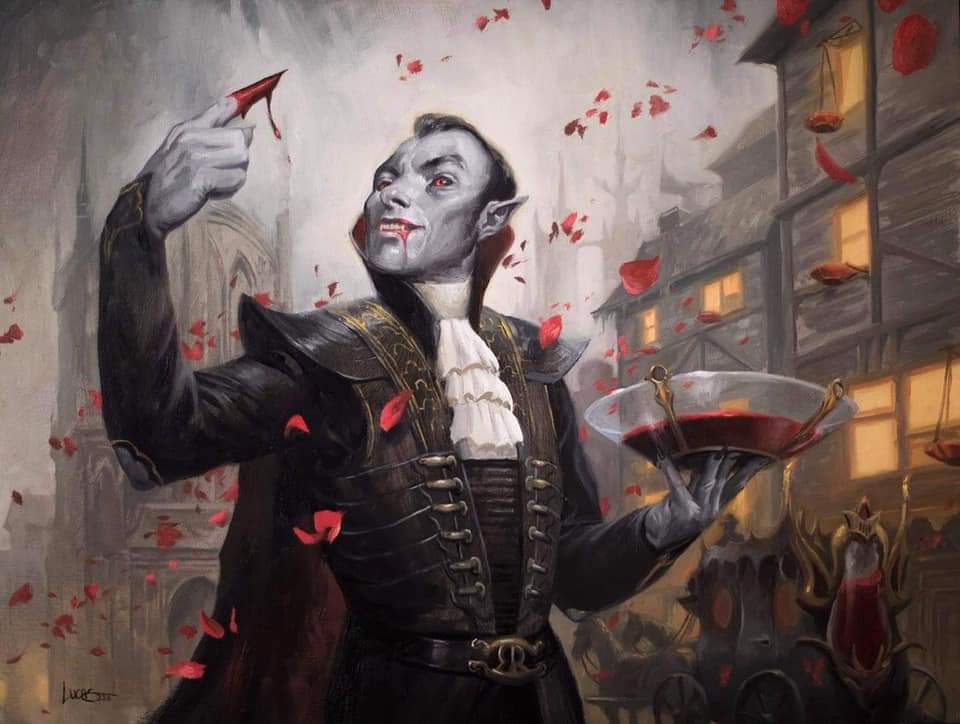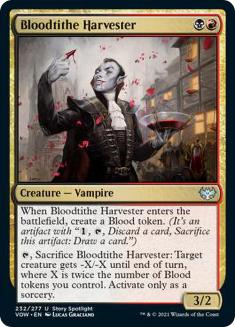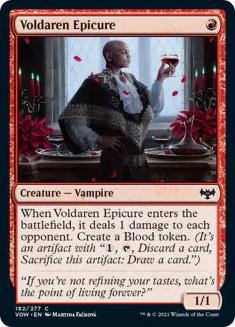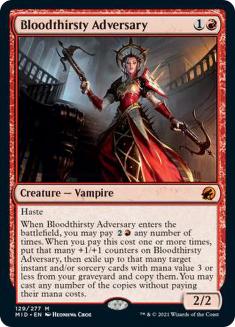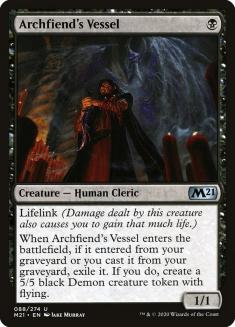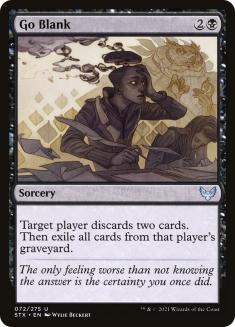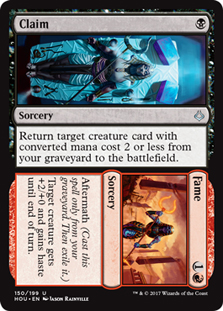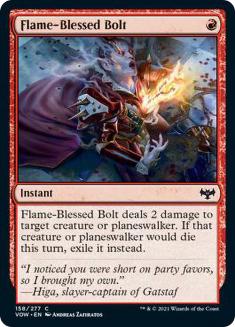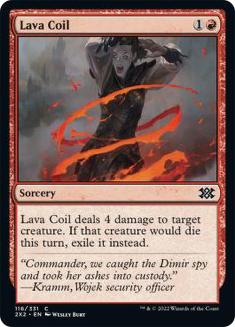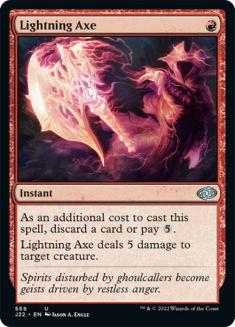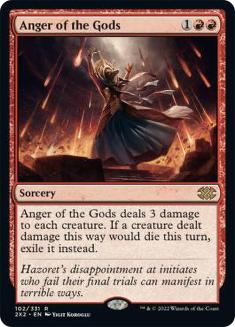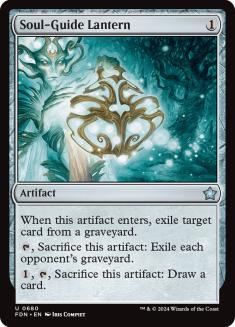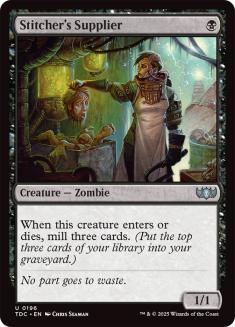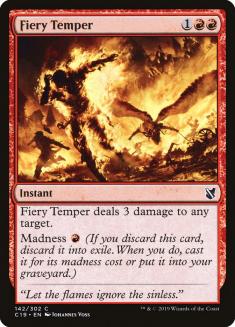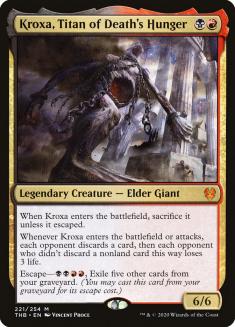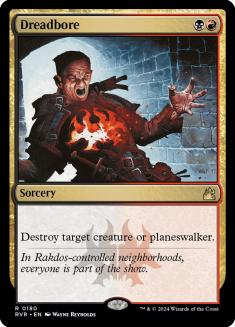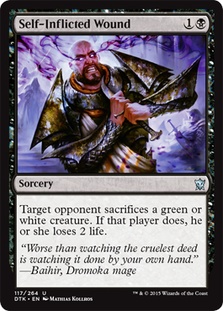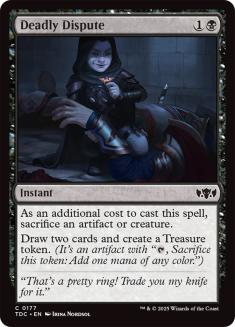I’m the Pioneer Guy™, and business is good!
Over the last two weeks and change, I’ve tried out most of what the format has to offer, and I’ve learned a lot along the way. This past weekend, I played a Pioneer Super PTQ on Magic Online with Boros Heroic (Lurrus), a deck I thought was the best in the format. I still believe that to be true, but Pioneer is a harsh format featuring a lot of Rock-Paper-Scissors matchups, and any deck can beat any other on the right day.
The deck that ultimately won the tournament was a play on an existing archetype, but this build came out of left field. I’ve seen a lot of mopey midrange Rakdos decks featuring Chandra, Torch of Defiance and other generic and powerful interaction, including the standout Graveyard Trespasser. None of those lists excited me at all, often feeling clunky or overly expensive. This new build is a straight up monster, and could easily become the new “hot” deck in Pioneer.
Black and red together aren’t really my favorite color combination because both colors excel at interaction but aren’t really known for their threats. Both perform well as monocolored decks but they’re usually linear aggro strategies, but pairing them together often fuses two colors with similar strengths and weaknesses. On occasion, a new card or set will offer up a host of cool interactions that override all of those preconceived notions. Out of nowhere, Innistrad: Crimson Vow and the Blood mechanic has given new life to Fatal Push and Fiery Temper, some of my favorite removal spells ever made.
Today, we’ll be going over the original list that won the PTQ, as well as some suggested changes after playing some Magic Online leagues with the deck. I’ll include a sideboard guide at the end if you’re into that sort of thing.
Without further ado, here’s Rakdos Blood, the best midrange deck in Pioneer.
Creatures (17)
- 2 Stitcher's Supplier
- 4 Kroxa, Titan of Death's Hunger
- 1 Archfiend's Vessel
- 2 Bloodthirsty Adversary
- 4 Bloodtithe Harvester
- 4 Voldaren Epicure
Lands (22)
Spells (21)

First of all, when someone figures out how to add a companion to an existing archetype, the results are often surprising, even if the overall power level of the deck seems to dwindle a bit. Removing cards like Graveyard Trespasser and Bonecrusher Giant in favor of Bloodtithe Harvester and Voldaren Epicure means we’re not really functioning on the same wavelength anymore. Instead, our deck looks and feels a lot like the old Rakdos Arcanist builds but without the vulnerability to spot removal that we once had.
That doesn’t mean removal spells are useless against us, but they are much worse here than when we would play something like Young Pyromancer. Our creatures mostly that generate some small advantage when we cast them, and provide some sort of synergy or splash damage along with it. They all have mana value two or less so we can play Lurrus of the Dream-Den, which gives us a lot to do with our mana in later turns when we haven’t found enough gas.
The Good
So what are these new creatures all about?
Bloodtithe Harvester is a lot better than it looks on paper. After playing with it a few times, I have to say it is now my favorite card in the deck. Not only does it do some serious damage against opponents without interaction, but it can turn on a dime and pick off an annoying opposing creature. It can be recast easily and aggressively with Lurrus and works better in multiples. The Blood token works with Fatal Push and Fiery Temper, but in a pinch can just be used to discard Kroxa, Titan of Death’s Hunger and dead removal/extra lands.
Cards that provide immediate resources, even if those resources are weak, are often some of the best creatures you can play. We learned a lot from Gilded Goose, but it took me quite a few games to realize just how much the Blood tokens actually added to the gameplay. They let you cycle Fiery Temper to essentially draw an extra card, but mostly they just let us spend most or all of our mana on every single turn. In Pioneer specifically, I’ve found that using every point of mana is a great way to win the game. That’s why Mutavault and similar utility lands are so important for midrange and aggressive decks to function properly.
Creatures that function as removal are uncommon in Magic, but are often excellent. Grim Lavamancer, for example, is one of my favorite creatures of all time. I am sad every day that it isn’t in Pioneer. While Bloodtithe Harvester isn’t quite the same as Grim Lavamancer, it gives you some pressure coupled with dynamic gameplay and interaction. What more could you ask for? Once I realized just how integral Bloodtithe Harvester was to the archetype, everything else started making a lot more sense.
While this one isn’t as powerful as Bloodtithe Harvester, it is similarly good because it generates a couple of small advantages. The body can be sacrificed to Deadly Dispute, apply a small bit of pressure, or chump block. It acts like extra copies of Stitcher’s Supplier in that it performs an important, albeit small, role in the deck’s composition.
I’ve always loved Goblin Dark-Dwellers, so you can imagine how happy I was when they printed a similar card at a similar cost that was a bit more friendly for Lurrus! Bloodthirsty Adversary hasn’t quite been as strong as Goblin Dark-Dwellers was back in Standard, but a lot has changed since then. Of all the decks I’ve seen play Bloodthirsty Adversary thus far, this one uses it the best by a wide margin.
When you bring it back with Claim // Fame, you can cast that extra spell for pretty cheap. When you bring it back with Lurrus, you get repeatable interaction and card advantage. I don’t like loading up on them, but plenty of Rakdos decks have played two Goblin Dark-Dwellers in the past. The trick is making sure you play enough spells that it can get value out of when you hit the magical five mana.
The creatures aren’t the only things that got a boost with this new build.
The Blood tokens allow you to turn on revolt for Fatal Push, which has traditionally been somewhat difficult in Pioneer specifically thanks to the banning of fetchlands. Fabled Passage isn’t quite as good as Wooded Foothills, but you gotta do what you gotta do when times are tough. With that said, this is the best Fatal Push deck I’ve ever seen in Pioneer, specifically because it can answer Winota, Joiner of Forces or other four-drop threats on the cheap. While it does make it cost one more mana in a realistic sense, turning Fatal Push from “B: kill a two-drop” to “1B: discard a card, draw a card, kill a four-drop” isn’t a bad thing.
Fatal Push is already elite-tier removal in most formats, including Pioneer, but this deck somehow making it better fluidly just adds a new dimension to an already stellar card.
The Bad
With new lists come some potential problems, and I’ve noticed a few already that I’d like to shore up quickly. Here are the cards I wasn’t a fan of:
This deck doesn’t win a lot through sheer pressure, so a 5/5 isn’t that much different from a small body in the long term. We just want game pieces that replace themselves or interact with our opponent, and Archfiend’s Vessel feels a lot like an aggressive element in a control deck. While it could be powerful, and certainly do the job it set out to do, it takes a lot of work and the payoff is mediocre. Drawing Archfiend’s Vessel for the first time will have you wanting to cut it immediately. I know I’d much rather be playing more copies of Stitcher’s Supplier.
These two discard spells are fine for the sideboard, but I found them both absurdly weak in the maindeck. A single Duress is often much worse than Thoughtseize, as it can’t take creatures. At times, you can actually miss when you cast it early, which is somewhat nightmarish. Go Blank is a little slow, which makes it an easy candidate for a cut. If there were more graveyard decks running around, like Izzet Phoenix, I would want more, but that’s why we just put it in the sideboard.
In decks featuring Young Pyromancer or Dreadhorde Arcanist, Claim is an excellent card because it returns a significant threat to the battlefield for a single mana, and can give it haste in the later turns. This deck is full of sticky creatures with mediocre abilities, so returning any one of them to the battlefield isn’t all that great. In a pinch, those old Arcanist decks would burn extra copies on Kroxa, Titan of Death’s Hunger when you wouldn’t have good targets. This deck has no good targets.
These two cards do similar things. Lava Coil is weaker against cheap aggro but better when your deck lacks real answers to Kalitas, Traitor of Ghet. I’m not sure which one I want yet, but for now I’m going to lean on Flame-Blessed Bolt and add in another Anger of the Gods to help out against creature-rush strategies. While we do have a ton of spot removal to clean up early pressure, sometimes your opponent will go far over the top, and only a sweeper can save you.
The Update
With a lot of games under my belt, here is the list I recommend moving forward, though I suspect this will change a few more times over the next few weeks.
Creatures (18)
- 4 Stitcher's Supplier
- 4 Kroxa, Titan of Death's Hunger
- 2 Bloodthirsty Adversary
- 4 Bloodtithe Harvester
- 4 Voldaren Epicure
Lands (23)
Spells (19)

As I talked about before, I am a big fan of Fiery Temper in this deck, so I wanted to add at least one more to help make the Blood tokens a bit stronger. Adding another means we probably want at least one more way to discard them, hence my addition of Lightning Axe. Not only does it kill Winota, Joiner of Forces, it handles just about all the midrange problem creatures in the format. You have enough graveyard synergy and random spouts of card advantage that a discard every now and then that is just “minus one card” is acceptable for an efficient removal spell.
After playing ten or so matches, I found myself wanting at least one more sweeper effect. Anger of the Gods has some negative affects for your stuff, but there are enough “sticky” creatures in Pioneer to warrant this sweeper’s exile effect. It is specifically one of the easiest ways for you to deal with Arclight Phoenix rushes that bulldoze your early interactive starts.
I found myself wanting, nay, needing more graveyard interaction. Soul-Guide Lantern just happens to be the best at our disposal, works with Lurrus, and handles most of the problem cards that could be thrown at us.
Sideboarding
VS Izzet Phoenix
Out:
In:
Kroxa is pretty awkward against Arclight Phoenix. It allows them to turbo one out in the early turns, which is the easiest way for you to lose the game. Your deck has plenty of answers for Thing in the Ice, but Arclight Phoenix recurring or just hitting the air quickly is dangerous, and I just don’t think Kroxa is how you’re supposed to beat them. As a result, we’re cutting Stitcher’s Supplier, which is similarly weak in the matchup and no longer has anything to enable. Fiery Temper and Lightning Axe are also not at their best there, but the cards we’re bringing to the table will answer just about everything they got.
This is not a great matchup. Anyone playing Treasure Cruise or Dig Through Time can beat Thoughtseize. That’s just how the cookie crumbles, and is a major part of the Rock-Paper-Scissors metagame I talked about earlier. Your sideboard stuff does a lot of exiling, which can grind pretty well, but it is basically impossible to beat Treasure Cruise once the engine gets rolling. It’s just too many resources wrapped into one single card and one single mana. That’s why we’re attacking their graveyard so hard.
VS Four-Color Jeskai Ascendancy
Out:
In:
Combo decks have very few creatures in Pioneer, so you’ll want to trim a bunch of it when possible. If they show you Omnath, Locus of Creation in the first game, I’d consider leaving in some number of Fatal Push, but you don’t want to draw more than one removal spell in most games.
Discard is great here, putting your opponent into topdeck mode as quickly as possible. Duress and Thoughtseize can take their big draw spells or their Jeskai Ascendancy. Go Blank can finish off their hand and make Treasure Cruise a lot slower.
VS Lotus Field Combo
Out:
In:
This matchup is similar to Jeskai Ascendancy, but I don’t think your removal spells are ever good. I would try to get all of them out and replace them for any other spell. Even Soul-Guide Lantern, a card that is mediocre at best in this matchup, is better for you than spot removal.
VS Mono-Red Aggro
Out:
In:
We’ve essentially pre-sideboarded for aggro decks, with an added Fiery Temper and two Lightning Axe. As a result, we don’t have much to bring in, but we should be fine for the most part. Lava Coil can deal with just about every opposing creature, while Anger of the Gods will protect us when they try to go wide. The only thing I’m really worried about is Chandra, Torch of Defiance, but the majority of her strength comes from killing opposing creatures. Since our creatures are individually weak but rather strong with our gameplan, her removal ability is weakened significantly.
VS Boros Heroic
Out:
In:
This matchup is tricky, but easily winnable. We need to hit them on all fronts. Killing their creatures is top priority, but we also need to keep attacking their hand to strip them of their protective elements. Both Duress and Thoughtseize are great for slowing down their interactions and allowing our slower removal like Lava Coil to actually do its job.
This is exactly the type of deck we prey upon, since most of our removal costs equal to or less than the mana value our our opponent’s creatures. We just need to shrink our win conditions and focus on interacting rather than trying to accrue minor advantages. Let our cards do the work.
VS Naya Winota
Out:
In:
Against creature-based decks, we often don’t have time to play card draw spells. We want to spend all our time and mana on removal. Stitcher’s Supplier is also better against slower opponents where we have time to develop. As it stands, in this matchup, it just chump blocks and mills three cards. Since we’re also bringing in Anger of the Gods, we want to trim a few of our synergy creatures, and I think Voldaren Epicure is the better of the two.
VS Azorius/Dimir Control
Out:
In:
Shark Typhoon is their only real creature, so you can safely remove most of your anti-creature spells. Duress and Go Blank interact with their hand, which is a great way to strip them of their big card draw or powerful payoffs. These decks really struggle beating Kroxa, but it takes the entirety of your deck’s focus to fight through all their interaction.
After sideboard, they will have Rest in Peace or other anti-graveyard spells, which can make Kroxa worse. In those games, we’ll have to just rely on our pinpoint discard to protect our creatures from their sweeper effects. Let the mediocre beatdown commence!
VS Mono-Black/Orzhov Vampires
Out:
In:
I want a few more removal spells, and specifically something that can handle Kalitas, Traitor of Ghet; Edgar, Charmed Groom; and Blood Baron of Vizkopa. Thoughtseize can become dead in a hurry, as Vampires decks can empty the hand and stay that way. Discard is also mediocre when both decks are just removal and resilient creatures.
This matchup is okay, but they act on a similar wavelength and have Sorin, Imperious Bloodlord and have Kalitas, Traitor of Ghet. Things can get wild.
VS Rakdos Blood (Lurrus)
Out:
In:
We have too much removal for this matchup. As you already know, killing creatures doesn’t really accomplish much. The main goal is to trade as much as possible until you find Kroxa. We should do that more fluidly since we added more copies of Stitcher’s Supplier, but it is certainly tough to deal with long-term. Fatal Push and Dreadbore will only get you so far.
After sideboarding, both Go Blank and Soul-Guide Lantern are sick, offering graveyard interaction with a little twist. Getting some excess removal out in favor of those two pieces of interaction is key for winning the mirror.
Final Thoughts
I’m loving Pioneer so far, and every week only brings more attention and more ideas to explore. In just the last few Leagues, I’ve battled a ton of different archetypes, including but not limited to Gruul Company, Mono-Blue Curious Obsession, and even Abzan Aggro! I get a lot of questions asking me what I think the best deck is, and I’m leaning toward some build of Rakdos Blood, though I don’t think we’ve found the best build yet. Plus, I think the “correct” removal spells will change from week to week based on what we’re expecting to play against.
The biggest draw of Pioneer is the gameplay. There are a few bad apples like Lotus Field, Jeskai Ascendancy, and Winota trying to ruin my good mood, but there’s still something charming about slamming a Damping Sphere against an opponent who just sacrificed all their lands. Rakdos Blood is just the next iteration to take the spotlight while a ton of eyeballs are drawing themselves to the format. What do you think will pop up next? My gut is telling me it’ll be Enigmatic Incarnation or Collected Company!
Now doesn’t that sound like fun?

